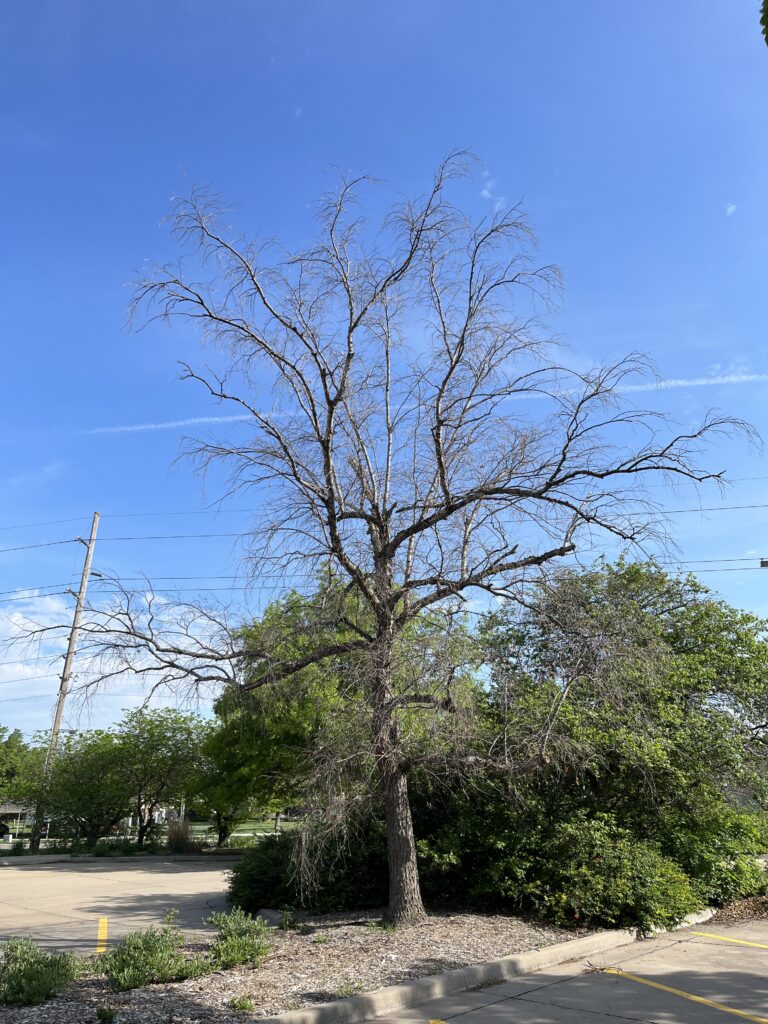One of the hardships of being a gardener is the loss of a long established tree. It is no different here at the Arboretum. We have lost a few trees that were planted at the founding of the Arboretum. The loss of these large specimen trees leave a huge hole in the landscape that will take another few decades to fill.
Austrian Pines
We continue to lose a few pine trees each year. All of our Scotch pines are gone due to pine wilt. We are now losing larger ponderosa and Austrian pines. We have a tree that is over 40 years old that was green last fall but is now totally brown, dead in less than six months. This could be due to a number of factors such as drought (although we watered it last summer into the fall), or some sort of tip blight. We believe this browning is blight. We are removing these trees as they die, which is heartbreaking.
Southwestern White Pine
This was one of the evergreen trees I recommended to plant a few years ago. It is no longer a viable alternative to some of the other two and three needle pines that have been lost to disease. We have lost a row of these due to pine wilt. Pine wilt causes a rapid decline of a pine tree in just a few months. The infected trees must be removed and burned to stop the spread.
River birch
In our parking lot median, we have slowly been losing an original row of river birch. Admittedly, this was not the ideal location for river birch. We were watering these trees almost weekly in the summer since they are not very drought tolerant and have shallow roots, which leaves them stressed in the heat sink of the parking lot. I see this same river birch scenario in other landscapes with river birch planted front yards and drier areas. Often times, these trees are struggling just as ours were unless they are receiving frequent irrigation through the summer. As their name implies, they grow best in wetter areas along streams, swales and ponds. We are replacing our river birch with a variety of deeper rooted trees such as oaks.
Autumn Purple Ash
What a big surprise this spring when this large white ash didn’t leaf out. One side has leaves, but the other side is completely bare. It has been infested with borers with have damaged the trunk, branches and stems. It showed no signs of disease last year. Even if I had seen and diagnosed the problem last fall, the treatment would not have been very effective. The result would have been the same. We are holding out hope that it will miraculously leaf out yet this spring. If not, it will need to be removed.
Pin Oak
It is well known that pin oaks suffer from iron chlorosis, which causes a yellowing of the leaves. Chlorosis in pin oaks is usually due to a deficiency of iron in the leaves. Iron is important for chlorophyll synthesis in plants, so when it is deficient, leaves cannot make chlorophyll, resulting in a yellow appearance. Chlorosis of pin oaks is typically associated with alkaline soil pH – pH greater than 7, which is common in our area. This iron deficiency eventually weakens the tree and stunts its growth. Trees can be treated by injecting iron into the trees or trying to change the pH of the soil. However, it is better to not plant these trees in our area. We are removing these trees and replacing them with varieties that don’t suffer from iron chlorosis.
Bottom Line
Having trees in Kansas is a luxury, especially large long-lived trees that provide wonderful shade. Kansas weather – with its extremes-wet, dry, hot, cold, and wind – are all challenges for trees. The other thing to keep in mind is that our area was originally prairie. Prairie is what grew best here, with trees relegated to creek bottoms and wetter areas. So growing trees here will always be demanding and ambitious. Even if we do everything right regarding trees in the landscape, there is no guarantee that a tree will grow and thrive.
We will continue replacing and planting trees here at the Arboretum. I believe a diverse selection of trees – different from the trees we have lost – is the answer. We will continue to lose trees, because they are living organisms susceptible to all sorts of diseases and problems. But keep planting, folks!
Recommended trees and shrubs from Kansas Forest Service




